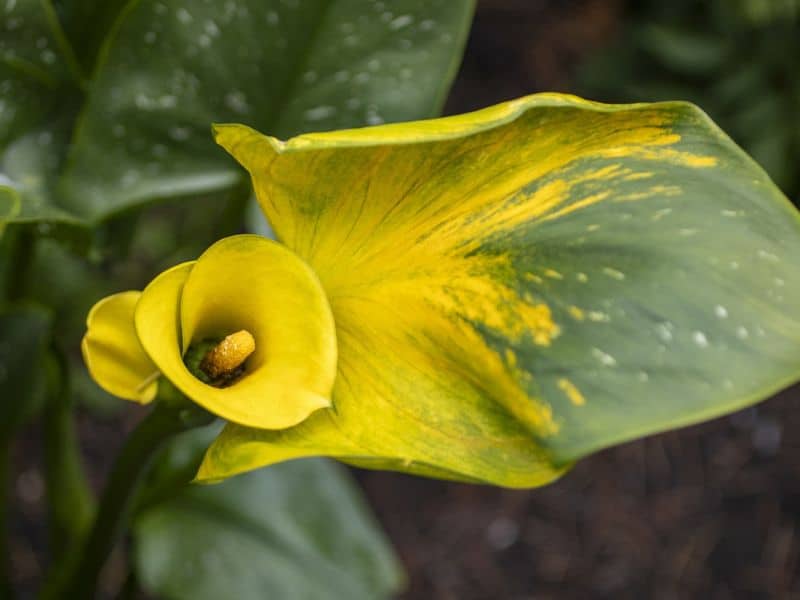You’ve nurtured your calla lilies with care, but now you’re noticing a troubling change: their vibrant green leaves are turning a sickly yellow. This can be a disheartening sight for any plant lover.
But don’t fret just yet. This could be a symptom of a common issue that’s often easy to resolve.
In this article, we’ll explore the possible reasons behind this color change and provide you with effective solutions. By the end, you’ll be equipped to restore your calla lilies to their former glory. So, let’s roll up our sleeves and dive into the world of plant care.
Understanding Calla Lily Leaves Turning Yellow
Causes of Yellowing Leaves
If you’re noticing your calla lily leaves turning yellow, this could indicate a variety of issues. Firstly, consider water-related problems; inconsistent watering, either too little or too much, could lead to leaf discoloration.
Overwatering, more precisely, makes it difficult for plants to receive oxygen, causing the roots to rot and leaves to turn yellow. Conversely, underwatering leads to dehydration, and you notice this in leaf yellowing.
Secondly, nutrient deficiencies are often responsible for yellowing leaves. For example, nitrogen deficiency restricts the production of chlorophyll, required for the green pigmentation in leaves; thus, they turn yellow. Similarly, iron and magnesium deficiencies could trigger the same effect.
The Lifecycle of Calla Lily Leaves
Understanding the lifecycle of calla lily leaves assists in maintaining plant health. Initially, they flourish as vibrant green leaves, but over time, like all plants, natural aging occurs. This aging process can cause the leaves to turn yellow, which isn’t cause for concern unless it’s happening prematurely.
However, if your plant is healthy and still young but the leaves are turning yellow, this suggests your calla lily may be experiencing stress. This stress could be from the previously mentioned water-related issues or nutrient deficiencies. Understanding and rectifying these conditions contribute immensely towards keeping your calla lily vibrant and healthy.
Common Issues That Lead to Yellow Leaves

Comprehend the vital factors that trigger leaf discoloration. It’s essential to have a grasp of the following common issues.
Overwatering and Underwatering
Watering heavily or sparingly affects calla lilies’ health. When giving excess water, roots suffocate and stress, causing the leaves to turn yellow. Furthermore, underwatering leads to dehydration, which initiates a loss in turgidity, resulting in yellowing too. It’s a fine balance, and determining the right amount could be tricky, but it’s key to keeping the leaves green.
Nutritional Deficiencies
Adequate nutrients are non-negotiable for calla lilies. With limited nutrients, specifically nitrogen, iron, and magnesium, leaves can display yellowing signs. Complementing your calla lilies with a balanced fertilizer replenishes their nutrient content, returning the lush green leafy hue.
Pest Infestations and Diseases
Beware of the silent threats lurking in your garden. Pest invasions and diseases drastically affect the plant’s health. Spider mites, aphids, and diseases like root rot and fungal infections often drive your calla lily’s leaves to a yellow state. Keep an eye out for these usual suspects; early detection increases the chance for effective treatment, helping maintain your calla lilies’ vibrancy.
Diagnosing the Problem
Unveiling the cause behind your calla lily leaves turning yellow involves a strategic approach. This section specifically targets two crucial steps: firstly, analyzing the environmental conditions, and secondly, identifying apparent signs of stress on your beloved plants.
Assessing Environmental Conditions
Start your diagnosis by evaluating the current growing conditions. Calla lilies thrive in well-drained soil and partial to full sun exposure. Be critical and objective as you review your watering routine, considering the possibility of underwatering or overwatering.
Analyze the soil type and monitor the pH levels, as optimal growth occurs in the slightly acidic to neutral range, 6.0 to 7.0 for instance. Examine your plant’s location–is it getting sufficient light, or possibly too much? Understanding these conditions helps pinpoint problems, if any.
Recognizing Signs of Stress on Calla Lilies
Monitoring your plants regularly aids immensely in early detection of stress signs. Besides yellowing leaves, another telltale sign of stress includes browning leaf tips. Additionally, remember that a sudden leaf drop is usually an indication of a serious health issue.
Quick responses, such as adjusting watering practices or treating pest infestations promptly, can prevent escalating problems and significant damage to your calla lilies. In the end, proactiveness is paramount in caring for your plants.
Remedies and Prevention Strategies

Proper Watering Techniques
Master the art of watering for maintaining vibrant calla lilies. Overwatering often results in waterlogged soil, causing leaf discoloration. Initially, let the soil around your plant dry out between watering sessions.
Gradually determine an optimal watering schedule, consider factors like local weather conditions and soil type. A simple moisture meter helps to keep tabs on soil wetness levels, aiding in the prevention of overwatering.
Ensuring Adequate Nutrition
Calla lilies thrive in nutrient-rich soils. Spotting yellow leaves points to potential nutrient deficiency. Make a habit of feeding your plants with balanced, slow-release fertilizers rich in Nitrogen, Phosphorus, and Potassium.
Early spring, summer, and throughout the blooming period can be marked periods for fertilization. Remember, over-fertilization may well lead to salt build-up, which in turn could cause leaf burn. Examine your lily’s growth patterns while adjusting the frequency and concentrations of feedings.
Control of Pests and Disease
Pests and diseases can swiftly turn your lily leaves yellow. Regularly inspect your plants for elevated pest activity and signs of disease such as leaf spots and fungus.
Utilize organic insecticides and fungicides as soon as possible, in case your plants are under attack. In situations that become unstoppable, consider seeking professional pest control services.
Best Practices for Calla Lily Care
Adopting a proactive care regimen leads to healthier calla lilies. Routinely prune wilted flowers and yellow leaves to stimulate growth. Make sure that your plants reside in well-drained, fertile soil and are exposed to the right amount of sunlight.
A suggestion for indoor lilies, replicate their natural environment as precisely as can be. Through keen observation and appropriate measures, you’re fostering a more robust and thriving plant.
FAQs
Why are my calla lily leaves turning yellow?
Yellowing of calla lily leaves can be due to several factors such as inappropriate watering practices (either under or over-watering), lack of necessary nutrients, or pest and disease infestations.
What are the remedies for yellowing leaves in calla lilies?
To remedy yellowing leaves, ensure proper watering balance, provide adequate nutrients through regular fertilization, and keep a check on pest infestations or disease symptoms. Implement proactive care by pruning and providing well-drained soil & appropriate sunlight exposure.
What are the best practices for calla lily care?
Best practices include regular pruning, ensuring well-drained soil, managing adequate sunlight exposure, and timely nutrient provision. Regularly check for signs of stress and modify care practices accordingly.
Why is it important to monitor environmental conditions for calla lilies?
Monitoring environmental conditions can help detect stress signs early, enabling prompt remedial actions to maintain the health of the calla lilies.
How can I prevent my lily leaves from turning yellow?
Prevention strategies include adequate watering but avoiding water stagnation, regular fertilization to address nutrient deficiencies, controlling pests and diseases, and providing ideal growth conditions like proper sun exposure and well-draining soil.
Up next: Ivy Leaves Turning Yellow: Identifying Causes and Providing Effective Solutions







